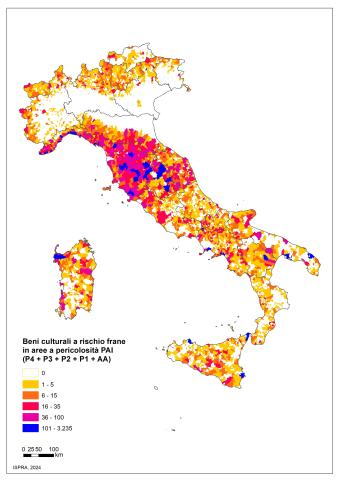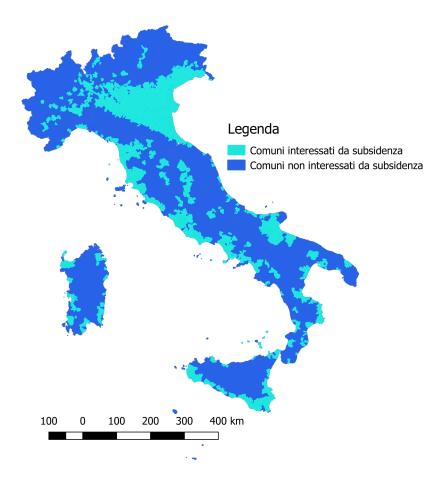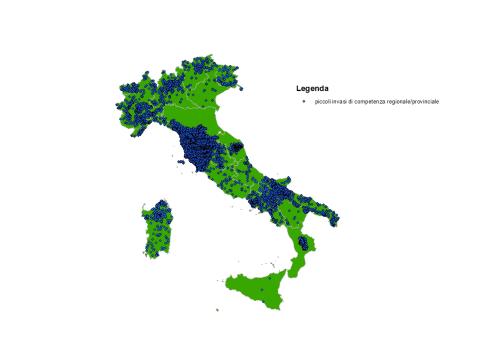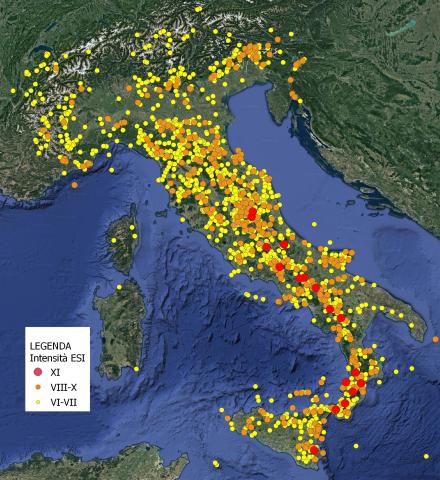Aree
CULTURAL HERITAGE EXPOSED TO LANDSLIDES AND FLOODS
Data aggiornamento scheda:

The indicator provides information relating to cultural heritage at hydrogeological risk on the national territory. There are 45,339 cultural assets at risk of landslides, of which 13,966 are located in areas with high P3 and very high P4 danger. The cultural assets at risk of flooding are 35,997 in the medium hydraulic danger scenario (return times between 100 and 200 years) and reach 54,103 in the low hydraulic danger scenario, which is the maximum expected scenario.
EVENTI SISMICI
Data aggiornamento scheda:
The indicator describes seismic events that occurred in Italy during the reference year, based on Magnitude values recorded by the National Seismic Network of INGV. In 2024, no destructive earthquakes occurred in Italy. Only one event reached Magnitude 5 in the province of Cosenza, which nonetheless caused no significant surface effects. Additionally, 13 events with Magnitudes between 4 and 4.6 were recorded within Italian territory and across borders up to 100 km away. The number of earthquakes with Magnitude ≥ 2 in 2024 (2,031) is comparable to the number recorded in the previous five years, with a slight decrease in 2021. As usual, most events were concentrated along the Apennine arc, the Eastern Alps, and Eastern Sicily.
SUBSIDENCE-AFFECTED MUNICIPALITIES
Data aggiornamento scheda:

According to the collected data, subsidence affects approximately 18% of Italian municipalities, primarily in Northern Italy, particularly in the Po Valley. In Central and Southern Italy, the phenomenon mainly affects coastal plains. The most affected regions are Veneto and Emilia-Romagna, where over 50% of municipalities experience subsidence.
ARTIFICIAL RESERVOIRS
Data aggiornamento scheda:

The number of reservoirs classified as Large Dams, according to the Law of October 21, 1994, No. 584 and the subsequent Ministry of Public Works Circular 482/1995, is 529 (as of December 2023). Based on censuses provided by the regions up to March 2024, the total number of water bodies (artificial reservoirs, basins, natural lakes, ponds, marshes, etc.) is 33,646. Information on large dams is complete at the national level. For small reservoirs, censuses or estimates are available for all regions, although in some cases the information is partial and incomplete. It is estimated that at least 40% of these reservoirs contain dam structures.
ENVIRONMENTAL EFFECTS OF EARTHQUAKES
Data aggiornamento scheda:

The indicator describes the environmental effects induced by earthquakes and represents the susceptibility of the Italian territory to such effects. Susceptibility depends on the varying degrees of seismicity present in different portions of the Italian territory and the local geomorphological and geological characteristics. It also provides a map of the ESI (Environmental Seismic Intensity) values reached during known seismic history in Italy, representative of the effects that may occur again in the future due to similar earthquakes.
In 2022, only one earthquake was recorded in which seismic-induced environmental effects were reported. This was the earthquake that occurred on December 4, 2022, in the Aeolian Islands, with a magnitude of 4.5, which induced modest collapse phenomena in some sites on Lipari and Vulcano.